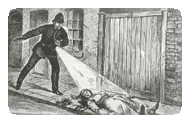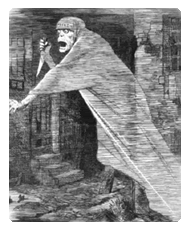Friday, October 01, 2010
September 29th, 1888/John Tenniel
September 29th was the evening of the "double event," the killing of Catherine Eddowes and Elizabeth Stride by Jack the Ripper.
Interestingly, that day saw a cartoon published in Punch titled "The Nemesis of Neglect," depicting a spectre-like figure with a knife "floating" along Whitechapel. This cartoon was drawn by John Tenniel, most famous for his illustrations of the Lewis Carroll masterpiece Alice in Wonderland.
The caption reads:
while the rest of the long poem was printed alongside the cartoon.
Tenniel also drew two other Jack the Ripper cartoons, one before and one after "The Nemesis of Neglect." He chose to comment on the societal impact of the killings rather than the specifics of the case. As this blog states, perhaps Tenniel found the grisly details too outre or distasteful to depict in cartoon form. Or, maybe he felt (as Bernard Shaw did, who called the Ripper a "solitary genius" for the murders' by-product of drawing interest to the plight of the denizens of the East End) that the case was about more than a seemingly random string of prostitute murders.
The first Tenniel cartoon, published on September 22, 1888, depicted the police's futility in apprehending the murderer:
The cartoon was accompanied by another rather long poem which ends with:
The final Tenniel cartoon with the Ripper as a subject appeared on October 13, 1888. This cartoon focuses on the members of the "criminal class" in Whitechapel and the dearth of policeman to combat crime in the East End:
The text reads:
While Tenniel's cartoon makes a good point about the lack of resources available to Warren as the Commissioner of Police during the Whitechapel murders, it again draws a distinction between the arrow-straight and thin policemen and the noticeably simian and atavistic features of the "criminal class." Alphonse Bertillon, whose "anthropometry," categorized criminals by facial and body features (including tattoos), and physiognomy, which also used physical features but went as far as to predict criminal behavior based on those features, were both popular at the time. However, at least as far as physiognomy is concerned, the practice was more an attempt to prove the superiority of one race over another (or all others) by proving the "primitiveness" of the other race.
It is interesting that the man who drew these timeless images of society's fears and anger at the seemingly motiveless crimes of Jack the Ripper also drew images which became synonymous with our images of the timeless Alice in Wonderland.
Interestingly, that day saw a cartoon published in Punch titled "The Nemesis of Neglect," depicting a spectre-like figure with a knife "floating" along Whitechapel. This cartoon was drawn by John Tenniel, most famous for his illustrations of the Lewis Carroll masterpiece Alice in Wonderland.
The caption reads:
There floats a phantom on the slum's foul air,
Shaping, to eyes which have the gift of seeing,
Into the Spectre of that loathly lair.
Face it--for vain is fleeing!
Red-handed, ruthless, furtive, unerect,
'Tis murderous Crime--the Nemesis of Neglect!
while the rest of the long poem was printed alongside the cartoon.
Tenniel also drew two other Jack the Ripper cartoons, one before and one after "The Nemesis of Neglect." He chose to comment on the societal impact of the killings rather than the specifics of the case. As this blog states, perhaps Tenniel found the grisly details too outre or distasteful to depict in cartoon form. Or, maybe he felt (as Bernard Shaw did, who called the Ripper a "solitary genius" for the murders' by-product of drawing interest to the plight of the denizens of the East End) that the case was about more than a seemingly random string of prostitute murders.
The first Tenniel cartoon, published on September 22, 1888, depicted the police's futility in apprehending the murderer:
The cartoon was accompanied by another rather long poem which ends with:
Mocking of glance, and merciless of mien.The police are depicted as fools, but, as others have pointed out, there is subtle racism within this cartoon as well. The people around the policeman have more animalistic than human features, which was in keeping with the attitude of many toward the minority races of Jews, Irish, etc. who occupied the East End. Therefore, it was doubly humiliating for the police to have the Ripper elude them and be laughed at by "inferior" races.
Mocking? Ah, yes! At Law the ghoul may laugh,
The sword is here as harmless as the staff
Of crippled age; its sleuthhounds are at fault,
Justice appears not only blind but halt.
It seems to play a merely blinkered gamer,
Blundering about without a settled aim,
Like boys at Blind-Man's Buff. A pretty sport
For Law's sworn guards in rascaldom's resort!
The bland official formula to-day
Seems borrowed from the tag of Nursery play,
"Turn around three times," upon no settled plan,
"Flounder and fumble, and "catch whom you can!"
The final Tenniel cartoon with the Ripper as a subject appeared on October 13, 1888. This cartoon focuses on the members of the "criminal class" in Whitechapel and the dearth of policeman to combat crime in the East End:
The text reads:
FIRST MEMBER OF CRIMINAL "CLASS." "FINE BODY OF MEN, THE PER-LEECE!"
SECOND DITTO. "UNCOMMON FINE! - IT'S LUCKY FOR HUS AS THERE'S SECH A BLOOMIN' FEW ON 'EM!!!"
"I have to observe that the Metropolitan Police have not large reserves doing nothing and ready to meet emergencies; but every man has his duty assigned to him, and I can only strengthen the Whitechapel district by drawing men from duty in other parts of the Metropolis." - Sir Charles Warren's Statement.
"There is one Policeman to every seven hundred persons." - Vide Recent Statistics
While Tenniel's cartoon makes a good point about the lack of resources available to Warren as the Commissioner of Police during the Whitechapel murders, it again draws a distinction between the arrow-straight and thin policemen and the noticeably simian and atavistic features of the "criminal class." Alphonse Bertillon, whose "anthropometry," categorized criminals by facial and body features (including tattoos), and physiognomy, which also used physical features but went as far as to predict criminal behavior based on those features, were both popular at the time. However, at least as far as physiognomy is concerned, the practice was more an attempt to prove the superiority of one race over another (or all others) by proving the "primitiveness" of the other race.
It is interesting that the man who drew these timeless images of society's fears and anger at the seemingly motiveless crimes of Jack the Ripper also drew images which became synonymous with our images of the timeless Alice in Wonderland.





















Post a Comment
<< Home